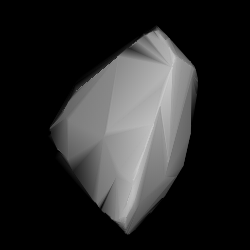 Modelled shape of Gunnie from its lightcurve | |
| Discovery [1] | |
|---|---|
| Discovered by | K. Reinmuth |
| Discovery site | Heidelberg Obs. |
| Discovery date | 10 October 1921 |
| Designations | |
| (961) Gunnie | |
Named after |
|
| A921 TH · 1930 XT 1968 HO · 1921 KM | |
| main-belt [1][3] · (middle) background [4][5] | |
| Orbital characteristics [3] | |
| Epoch 31 May 2020 (JD 2459000.5) | |
| Uncertainty parameter 0 | |
| Observation arc | 98.23 yr (35,880 d) |
| Aphelion | 2.9391 AU |
| Perihelion | 2.4485 AU |
| 2.6938 AU | |
| Eccentricity | 0.0911 |
| 4.42 yr (1,615 d) | |
| 181.91° | |
| 0° 13m 22.44s / day | |
| Inclination | 10.991° |
| 26.616° | |
| 285.28° | |
| Physical characteristics | |
| 21.361±0.002 h[9] | |
Pole ecliptic latitude | |
| 11.5[1][3] | |
961 Gunnie (prov. designation: A921 TH or 1921 KM) is a very dark background asteroid from the central regions of the asteroid belt, approximately 37 kilometers (23 miles) in diameter. It was discovered on 10 October 1921, by German astronomer Karl Reinmuth at the Heidelberg-Königstuhl State Observatory.[1] The C/X-type asteroid has a rotation period of 21.4 hours. It was named after Gunnie Asplind, daughter of Swedish astronomer Bror Asplind (1890–1954).[2]
- ^ a b c d Cite error: The named reference
MPC-objectwas invoked but never defined (see the help page). - ^ a b Cite error: The named reference
springerwas invoked but never defined (see the help page). - ^ a b c d Cite error: The named reference
jpldatawas invoked but never defined (see the help page). - ^ Cite error: The named reference
AstDys-objectwas invoked but never defined (see the help page). - ^ Cite error: The named reference
Ferretwas invoked but never defined (see the help page). - ^ a b Cite error: The named reference
AKARIwas invoked but never defined (see the help page). - ^ a b Cite error: The named reference
Masiero-2012was invoked but never defined (see the help page). - ^ a b Cite error: The named reference
SIMPSwas invoked but never defined (see the help page). - ^ a b c Cite error: The named reference
lcdbwas invoked but never defined (see the help page). - ^ Cite error: The named reference
SDSS-Taxonomywas invoked but never defined (see the help page).